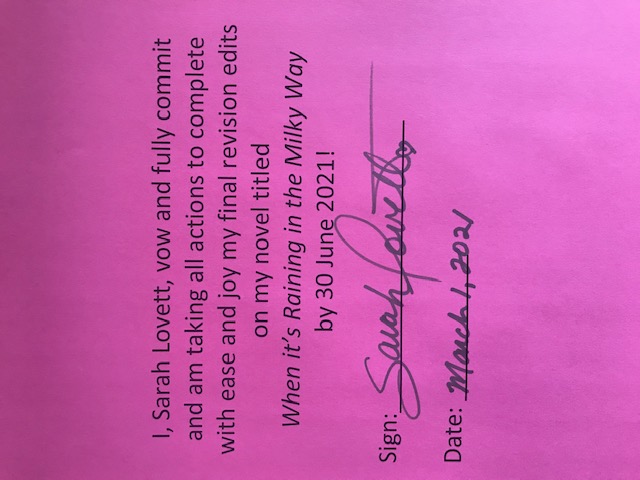Embarrassing confession: I’ve been putting off writing this post on “Accountability.” Yikes. It feels good to put my failure out there–wait, let’s drop the “F” word “failure.” (We all struggle with resistance.) And let’s drop that “A” word right now, too, deal? This post is about reaching your desired outcomes (or call them goals or aspirations) with joy and ease, no failure, no shame.
Action prompts
Next confession: I’ve been working on using B.J. Fogg’s Tiny Habits! This confession is awesome because his system is great and makes change so easy. It also reinforces discoveries I’ve made over the years with my own curiosity and tiny habits. For example, for more than a year, each morning when I start up the staircase to my office, I do 10 or more pushups. Admittedly, pushups on a slant are easier than if I were doing them on a level surface, but this tiny habit feels great and makes my biceps happy and firmer.

I didn’t realize it immediately, but I was following the Tiny Habit recipe by attaching a simple new and desired behavior (10 pushups) to a daily action prompt or habit, which is taking my first step to climb the stairs to my office. 1) Easy new and desired behavior (10 pushups) attached to 2) an already established daily action prompt, climbing the staircase to my office.
Tiny = No bar too low
Let’s focus on the easy new and desired behavior. One of Fogg’s examples is his decision to floss one (count it, one!) tooth (easy new behavior) after brushing his teeth in the morning (the already established action prompt). From there he did a little research and discovered the brand of floss that worked best for his teeth. And pretty soon he was flossing all his teeth, once in the morning and once at night. I call this “no bar is too low.” In fact, setting the bar low is vital. When we set BIG goals for ourselves, they can quickly loom and overwhelm us. And then we avoid them. And then we feel like failures. No bueno! Remember, this is a practice that does not include the possibility of failure or self-blame or shame.
Lovely low bars = 3 minutes per day or 1 page per day or…?
There are those writers among us who swear they sit down and whip out two-thousand words each and every day–crushing it when it comes to reaching deadlines on novels and memoirs. Bully for them! Remember, we are keeping the bar low in order to create a tiny new habit we will actually do! So your lovely low bar might be, “I want to write at least one page per day.” Alternately, it might be, “I am going to sit down at my writing desk for three minutes each day.” Great! Let’s look more closely at how to get going on your newest tiny habit. But first, one note about having fun!

Ease & Joy
My big words when it comes to a desired outcome while I’m writing are ease and joy! We work hard as writers so we deserve to savor and own the joy of our stories and our process, too. Even when our characters are suffering, we can seek the joy of our own writing/storytelling experience–and finish our first, second, and final polish drafts. So remember to celebrate your successes! I keep noisemakers and funny hats in my office and they remind me to smile because I love to write stories and work with writers!
Brainstorming desired outcome(s)
What is the first desired writing outcome you are aiming to reach? It can be finishing draft #3 of your memoir or it can be establishing a daily writing practice or it can be a hundred other aspirations! Let’s get started by brainstorming your desired outcome. Grab a sheet of paper and outline a big cloud and now jot your aspirations anywhere you want inside that cloud. You might have “revising my short story about a boy born with wings,” or “writing a rough draft of my essay on the evolution of Disney female heroes,” or “outlining my Science Fiction epic.” Now circle the one that seems the most enticing to you or the one that’s most pressing.

Discovering the easiest roads to reach your desired outcome(s)
On another piece of paper write your desired outcome in the center. Now quickly jot down behaviors that you believe will help you achieve your desired outcome. Your behaviors might include things like:
- Use daily writing prompts.
- Do more research.
- Set aside an hour each day to write my pages.
- Make a deal with a writer friend to exchange pages.
Make it even easier
These activities all make sense but they are broad and not tiny. So break them into smaller bits:
- I’ll choose one writing prompt a day, take 5 minutes, and write it from my protagonist’s viewpoint.
- I’ll take 3 index cards and jot one research question on each card.
- I’ll sit at my writing desk and write for 15 minutes each day.
- I’ll find a coach who can support my progress and tweak my process.
Now review your smaller, more specific activities and decide which ones you believe you can accomplish with ease. Set those into a “doable” pile. Aim to commit to one week of trying your new tiny habit. That will help you see if you need to break them into even smaller pieces.
And easier still
Now ask yourself, “What else can I do to make these new habits easier still?” Meaning, yes, I believe I can do them–with even more ease. Do you need help gathering writing prompts? I am very happy to support you by sending you a list to work from. You can also find many writing prompts on the web. (Mine are specifically geared to help you develop your characters and their backstories.)

Do you need to break down your research into first writing one question on a card or sticky note? Just write it down and put it where you see it. You will build up from there. What about adjusting your 30 minutes at your writing desk to, “I’m going to sit down at my writing desk for 3 minutes each day–and that’s all I need to do to start building my daily practice. ” From there, it’s very likely you will decide to write a few words and a few more words and so on. Remember, these new tiny actions you are building are habits you want to foster because they are leading you to your larger aspirations!
More action prompts
For this post, let’s revisit finding the right action prompt to inspire building your new desired habits with ease. By “right” I mean action prompts that already work for you. Let’s look at establishing a daily practice for example. One writer I know discovered that his most viable action prompt was when he pushed back his chair after finishing dinner with his family. He decided to use that action prompt to prompt him to walk straight to his writing office and sit down at his desk. He has a demanding day job and kids so this seemed his best shot. It worked! He’s writing daily, often 500 to 1,500 words per day. And he’s finishing the first draft of his first novel. Sure, he has days when he doesn’t get to his desk but it doesn’t take him long to get back on track.
Note: If he had tried that action prompt and it worked for one night but not the next, then no failure, no shame! It would simply have been the wrong action prompt for him to use. The solution=Look for new action prompts to try.
What do you need?
Again, we tweak as we go. I don’t want you to feel pressured or locked into anything, but I want you to feel curious and inspired to create tiny habits that you are able to do and that move you toward your desired outcomes. Tiny steps lead to big accomplishments! Or as my dear friend Karen Kenney (writer, coach and spiritual mentor) reminds me, “Small hinges swing open big doors!”

Look for upcoming posts on how to reach your most treasured aspirations with ease and a smile on your face. And send us your tips and questions and recipes for success. Oh, and do check out B.J. Fogg’s excellent book Tiny Habits.





